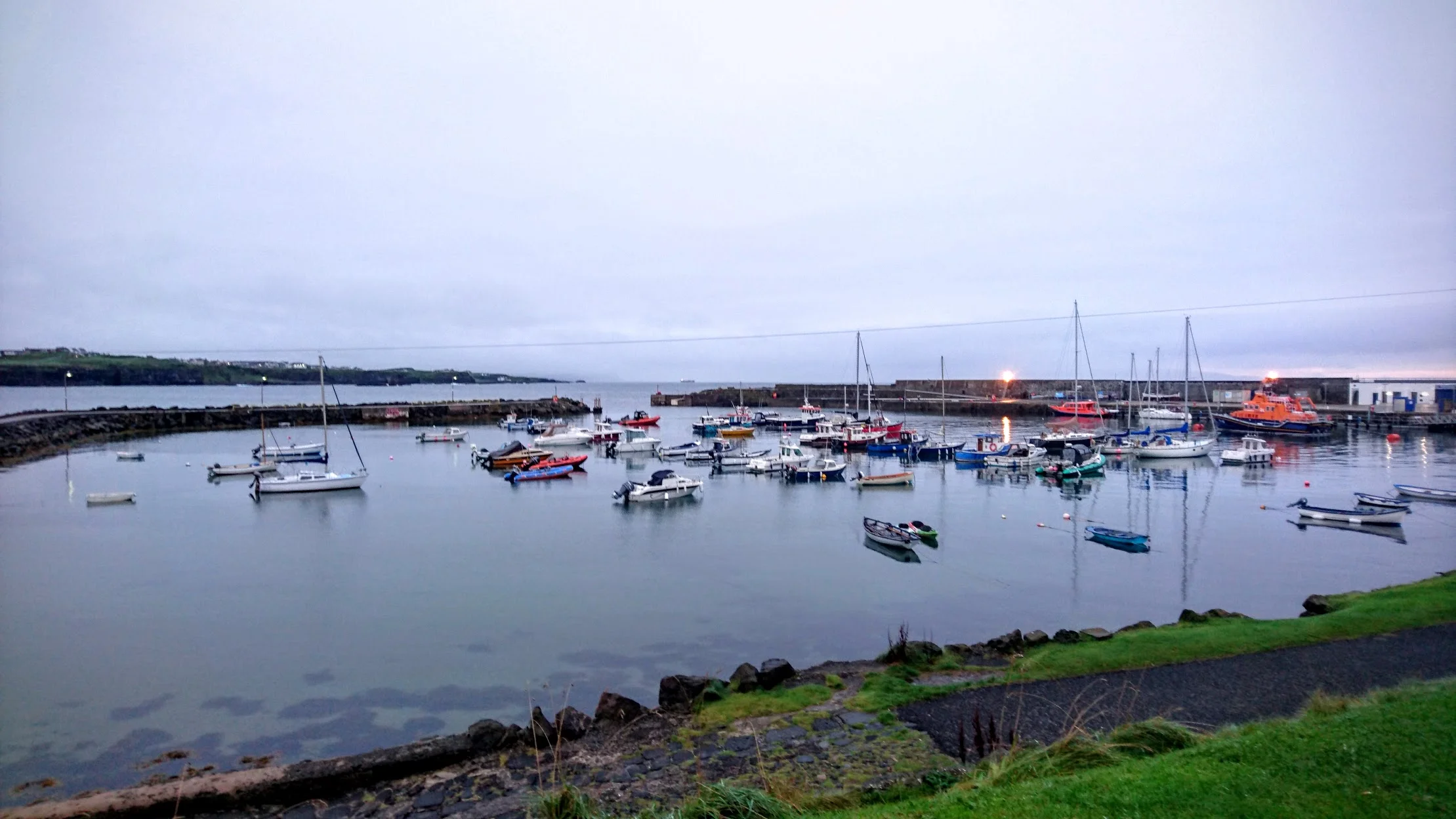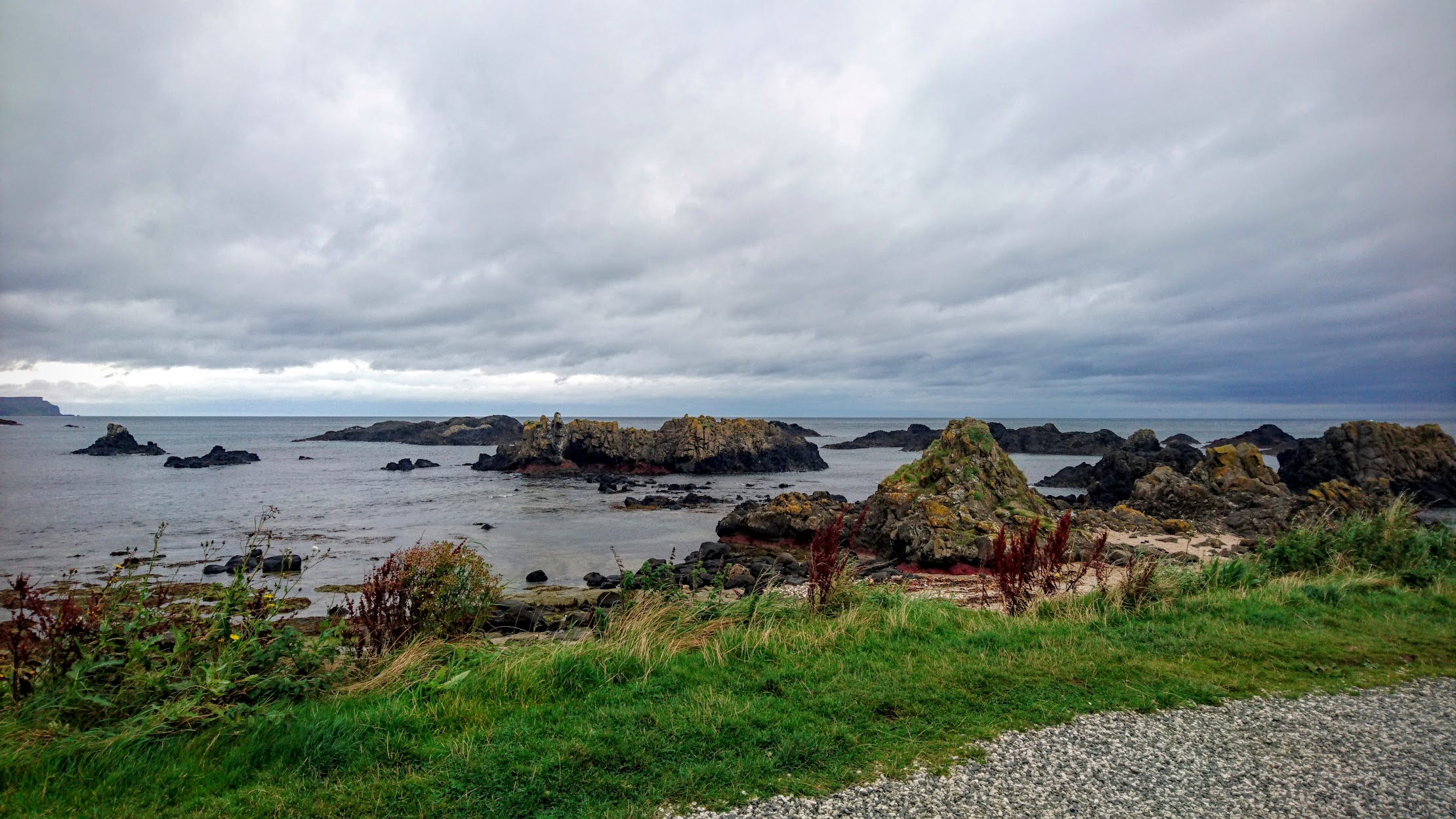Ride: Ballycastle, Northern Ireland to Portrush, Northern Ireland
Distance: 39.6km
Terrain: Loads of rolling drumlins as you continue along the coast, but all in all, not any worse than what you've already gone through in the previous days. The North Antrim Coast is littered with tourist attractions (they're like kittens, it keeps giving them away), so the day feels quite short because of the constant stopping and starting as you sail from one to another. If you're feeling up to it, you can add an additional 20km to the day's ride by heading south for a glimpse of the Dark Hedges. Read on, and you'll see why we didn't do that.
To interact with this map, visit Jess's Strava account here.
By the time we had gone to bed after our day in Ballycastle, the winds were still wailing and howling outside. It had gotten to the point where even the locals looked worried, and if things didn't improve in the morning, we were seriously considering staying an extra day here to let it pass. Rain here is an inevitable fact of life, and can be dealt with by dressing accordingly. But the wind is something we have no answer for.
It wasn't quite as bad when the sun came back up, but it still wasn't calm by any means, so we cast a critical eye over our planned route as we tucked into yet another Ulster Fry.
There's a lot to see on this stretch of coast, and on our hit list for the day was Ballintoy Harbour, the Giant's Causeway, the Dark Hedges, and the Bushmills Distillery. Fitting all of that in was going to be an undertaking in any conditions, but in this wind we decided the Dark Hedges was a stretch too far. Turning inland to ride along the famed beech-lined road would add 20 wind-lashed kilometres and a couple of hours to our day. It's a shame, but something had to give, and we'd prefer that it wasn't our resolve. There's a long way to go on this trip yet.
The B15 road carried us northwest out of Ballycastle, and being slightly inland afforded us a small amount of respite from the worst the North Atlantic had to throw at us. After about an hour of fairly easy riding, we reached Ballintoy.
To the bottom right, you can see the entrance to Carrick-a-rede ("rock in the road") Island. Accessible via a rope bridge that hangs almost 25 metres above the sea, it sits square in the middle of migrating salmon and houses a commercial salmon fishery. This also got dropped from our itinerary – today was no day to be standing on a rickety bridge.
Ballintoy Harbour below.
Ballintoy is a tiny, isolated town, and it would be easy to get the impression that nothing has happened since the last time Neil was here, on a school geography field trip twenty-odd years ago. But in fact, the town was also used in the second season of Game of Thrones as the setting for Lordsport in the Isle of Pyke, part of the Iron Islands.
In the show, the Iron Islands are barren, windswept rocks which left their residents little choice but to take to the sea for a living. They couldn't have found a better real-world match than little Ballintoy. The last census in 2011 counted just 150 residents, and it feels almost abandoned. During the hour or so that we spent walking around the shore, we didn't see a single soul.
What is dead may never die. And Neil did contemplate drowning Jess to get her through the tour.
Since you descend down a pretty steep, winding road to reach the harbour itself, you obviously have to climb up it to get back onto the main road. Normally, 12-13% hills wouldn't bother us, but since we were missing our lowest two gears, we kept our sneakers on in case we needed to jump off and push. But it went okay in the end, and in his excitement at reaching the top in one piece, Neil somehow threw his bike shoes into a bramble bush. Facepalm.
Wahey!
Our little fishing expedition complete, we continued our way along the coast, passing by Dunseverick Castle, which used to be the capital of the ancient kingdom of Dalriada in the sixteenth century and was at the end of one of the five great roads that led from Tara, the old capital of Ireland. Not much of it remains today, save for two very picturesque crumbling pillars. It really feels as if everything around here is slowly sliding into the sea.
As we pootled along to our next destination, we felt some raindrops falling on our heads. Nothing unusual in this, and as we pulled into the visitor centre at the Giant's Causeway, we were pretty unperturbed.
And then the sky unleashed its full fury.
Drenched.
Undeterred, we laughed, shrugged and parked our bike at the Causeway Hotel next door. Here's a tip - everything at the Giant's Causeway is set up to make you feel like you have to go through the visitors' centre to get to the rocks. This is because that's the only way they can make money out of you. Ignore all that and go around directly to the path behind the building - this will cost you nothing, and you can park your bike for free too.
As we sauntered down the gently sloping road to the rocks, our initial nonchalance towards the rain turned into utter disbelief. In the space of a couple of minutes, we had progressed on the local scale from "trying to rain", through "hardly raining" and "not really raining", all the way to "bucketing", and everyone looked absolutely miserable.
There is a £3 roundtrip bus service that takes you from the main entrance down to the rocks, but it only runs once every 15 minutes, and given that you had to stand in the rain waiting for it, you would be no drier, so we walked. And by the time we reached the fourth greatest natural wonder in the United Kingdom, our clothes were completely soaked through. But it wasn't like we could get any wetter now, so we stuck it out and started exploring. The phase, "What the hell are we doing?" was uttered many times.
Consisting of an estimated 37,000 black basalt columns in varying polygonal shapes, the Giant's Causeway is a UNESCO Heritage Site and major tourist point for people from all over - it receives hundreds of thousands of visitors each year. Most of the columns are hexagons, with pentagons and sometimes even decagons thrown into the mix, formed as a result of a underground volcanic explosion around 60 million years ago that stretched from the Causeway to Rathlin (near Ballycastle) and beyond to Scotland. What we see today is the molten basalt that burst onto the surface and cooled to create this vast stretch of organ pipe-like pillars.
Or, depending on who you believe, it was the work of a terrified giant hotfooting it back to Scotland to escape the wrath of the mighty Fionn Mac Cumhaill.
It truly is worth stopping for. You won't see anything like it in the world. Try to time your visit for a day when rain isn't imminent. Oh wait - when does that ever happen?
It was starting to get very chilly, and all we wanted to do at this point was head indoors. Cycling in wet clothes on a day like today is a good way to get yourself a cold. We quickly walked back, unlocked the tandem, and rode the 3km to the nearby town of Bushmills for lunch.
Believe it or not, this was when it had stopped raining for five minutes. Seconds after we took this photo, it started lashing down again.
The Copper Kettle, where we ate our way through two plates of sarnies and gallons of hot tea.
As its name suggests, Bushmills is where the eponymous distillery is located. Jess has been a huge fan of Bushmills ever since we went on a self-prescribed Irish whiskey tour through several bars in Dublin a couple of years ago. Visiting this place was high on our to-do list for this trip, and we couldn't wait to get tucked-into-the-liquor-we-mean-learn-all-about-the-distilling-process. At this point, poor Jess was starting to shiver uncontrollably, so the warmth of the distillery was most welcome.
The first thing you smell as you enter the parking lot is the distillery doing its work, and it can be overpowering at first. Whiskey has been legally distilled here since 1608, which makes it the oldest such production location in the world. Our tour guide, Trevor (highly recommended, this Trevor), led us through the distillery process, from when the grain mash first becomes fermented to when it goes through the distillation process, and then is casked for ageing until bottling time. The difference between Irish whiskey and Scotch whisky, apart from the spelling, is that the latter is only distilled twice using peat, whilst the former is distilled three times using clean, hot air. Casking itself is also quite intricate, involving American bourbon barrels and Spanish sherry casks that imbue their own flavours into the whiskey over a period ranging from 10-21 years.
An interesting fact that we also learned is something called the "Angel's Share" - the amount of whiskey that evaporates from the casks during maturation. This can be anywhere between 2-40% (the longer the whiskey ages, the more nature runs its course). Trevor told us a nice fairy tale about this, which is that when Bushmills first received its licence, it made a deal with the angels who owned the land. In exchange for allowing the distillery to produce whiskey on the premises, the angels would receive a percentage of the final result as a thank you.
We weren't allowed to take photographs during the tour due to the presence of alcohol evaporating in the air, but take our word for it - this is a must. Make sure to ask for Trevor.
Included in the price of entry is a glass of whiskey from their in-house bar. You can order from a variety of offerings, including the Bushmills 12 Year, which is matured mostly in sherry casks and only available inside the distillery itself. Nowhere else in the world has this variety on sale, and very nice it is too.
Bushmills 12 Year. Wonderfully tart and fruity at the same time.
In 2008, the Bank of Ireland issued a special "Bushmills Series" in commemoration of the 400th year since the distillery went into production. They are still in circulation today, and coincidentally, we had one in our pockets.
Feeling warm and toasty (and not just on account of the indoors), we walked back outside into the rain, which had subsided into a mizzle*, and made our way back to the coast for the final stretch towards Portrush. There were drumlins a-go-go once again, which made for a beautiful background as we rode past Dunluce Castle and the view opened up to the famed Portrush Strand below. You'd think by this point, we would be used to the gorgeous vistas that greeted us at the top of every climb. But this one was something special.
Another good view ruined by Mr. Photogenic.
*Mizzle: yet another category on the Norn Iron Rain Meter. A mash-up of "mist" and "drizzle".






























